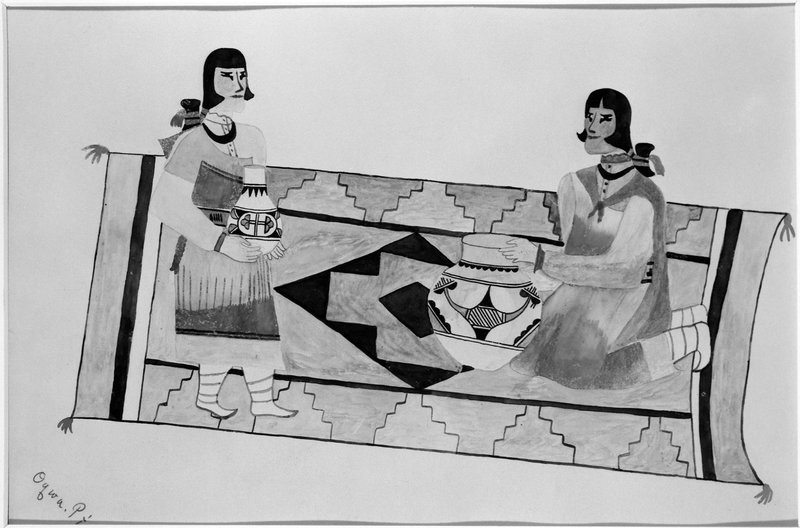Two Women on a Rug Item Number: 40.88 from the Brooklyn Museum

Description
Watercolor of two women sitting on a rug hold pottery. Oqwa Pi (Abel Sanchez) was one of several promising painters who learned the basics for mural painting and watercolor at the Santa Fe Indian School. Moving back to San Ildefonso Pueblo, he led an active life as a religious leader and statesman, holding the Tribal Governor position for six terms. In addition to raising his large family through his farming and fulfilling his extensive community obligations, he maintained a lucrative artistic career, fitting in painting between feast days and using his dining room as a studio. His work features scenes of secular ceremonies and of his community daily life. The San Ildefonso Pueblo walls, unlike many other Pueblos, did not have murals in their kivas. So the influences came from paintings found at Frijoles Canyon where figures were painted on an undecorated ground, often also found on ceramics. Thus the only grounding in this work is the women on top of the rug although the rug appears to be floating. The traditionally dressed figures appear to interact more with the viewer of than with each other. However the accuracy of the clothing, pottery styles and rug designs are accurately depicted.
Credit Line
Dick S. Ramsay Fund
Signed
Signed lower left recto in graphite "Oqwa Pi." At top edge in graphite is "20" and bottom right corner "53". At upper verso left in graphite is: "- 26" and "22." At the upper left edge in black ink verso is "40.88)
Label
Oqwa Pi (Abel Sanchez) was one of several promising painters who learned the basics of mural painting and watercolor at the Santa Fe Indian School. Moving back to San Ildefonso Pueblo, he led an active life as a religious leader and statesman, holding the position of Tribal Governor for six terms. In addition to raising his large family and fulfilling his extensive community obligations, he maintained a successful artistic career, fitting in his painting between feast days and using his dining room as a studio. His work features scenes of secular ceremonies and, as seen here, of his community’s daily life.
Item History
- Made by Oqwa Pi aka Abel Sanchez between 1930 and 1940
What
- Name
- Two Women on a Rug
- Identification Number
- 40.88
- Type of Item
- rug
- Material
- watercolor over graphite on wove paper
- Overall
- length 9.8125 in, width 14.25 in
Who
- Culture
- Po-who-ge-oweenge
- Creator
- Oqwa Pi aka Abel Sanchez
Where
- Holding Institution
- Brooklyn Museum
When
- Creation Date
- between 1930 and 1940
Other
- Classification
- Watercolor